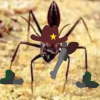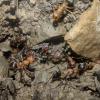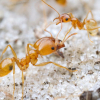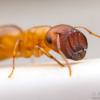- Formiculture.com
- Forums
- Gallery
- Members
- Member Map
- Chat

The Experimental Process of Creating Multispecies Ant Colonies
Started By
CheetoLord02
, Jan 10 2021 7:51 PM
multispecies colony multispecies
138 replies to this topic
#121
 Offline
-
Posted January 21 2023 - 10:41 AM
Offline
-
Posted January 21 2023 - 10:41 AM
True, but they have three or four times the ant diversity than Chile.
"The ants are a people not strong, yet they prepare their meat in the summer." Prov. 30:25
Keep ordinary ants in extraordinary ways.
Keep ordinary ants in extraordinary ways.
#122
 Offline
-
Posted April 5 2023 - 9:15 AM
Offline
-
Posted April 5 2023 - 9:15 AM
I meant to post something on Friday about this but became overwhelmed with work and school that I was unable to.
I decided to take a different approach to this same very experiment (So credit to those who started this for the idea).
I thought that the same thing could be done in a more applicable way if it was within the same species and that species has been known to be polygynous. I've had previous problems with my Prenolepis imparis queens dying so I thought I'd try it with them. So, I doused 4 caught queens (from recent nuptial flights) in vinegar for 20ish seconds, ensuring no air bubbles. I dried them off with cotton and put them in a test tube for a minute and added them one by one to a bunch of collected workers from a nearby colony. (I did test before this experiment and aggression was shown with the foreign queens) They quickly accepted them and were continuously licking them off for a few hours. They were brought into the nest and have been fed by some of the repletes. I'm still looking for egg laying to begin, but so far they have been peaceful and fully accepted to the colony.
My purpose of this was to see if vinegar could be used to help queens who had their workers die off, or for colonies in which the queen died off. The same concept works for dousing workers and introducing them to queens. I tried it with a Camponotus chromaiodes colony I have and the workers were quickly accepted and still aren't treated any differently after 2 months. I hope some of you find this applicable and will try and see if this is a possible solution to colonies dying out or worker die offs. I will continue to occasionally try it with other species as the season progresses, but so far it works with Camponotus (not sure if it works for all species, may need more study) and Prenolepis imparis. I didn't take any pictures of the process, but I will take pictures for my next one and document it the best I can for you all.
- ANTdrew, rptraut and Ernteameise like this
Keeps:
1:Pogonomymex occidentalis
4: Tetramorium immigrans
2 Reticulitermes flavipes
#123
 Offline
-
Posted April 13 2023 - 9:24 AM
Offline
-
Posted April 13 2023 - 9:24 AM
I meant to post something on Friday about this but became overwhelmed with work and school that I was unable to.
I decided to take a different approach to this same very experiment (So credit to those who started this for the idea).
I thought that the same thing could be done in a more applicable way if it was within the same species and that species has been known to be polygynous. I've had previous problems with my Prenolepis imparis queens dying so I thought I'd try it with them. So, I doused 4 caught queens (from recent nuptial flights) in vinegar for 20ish seconds, ensuring no air bubbles. I dried them off with cotton and put them in a test tube for a minute and added them one by one to a bunch of collected workers from a nearby colony. (I did test before this experiment and aggression was shown with the foreign queens) They quickly accepted them and were continuously licking them off for a few hours. They were brought into the nest and have been fed by some of the repletes. I'm still looking for egg laying to begin, but so far they have been peaceful and fully accepted to the colony.
My purpose of this was to see if vinegar could be used to help queens who had their workers die off, or for colonies in which the queen died off. The same concept works for dousing workers and introducing them to queens. I tried it with a Camponotus chromaiodes colony I have and the workers were quickly accepted and still aren't treated any differently after 2 months. I hope some of you find this applicable and will try and see if this is a possible solution to colonies dying out or worker die offs. I will continue to occasionally try it with other species as the season progresses, but so far it works with Camponotus (not sure if it works for all species, may need more study) and Prenolepis imparis. I didn't take any pictures of the process, but I will take pictures for my next one and document it the best I can for you all.
In my experience Prenolepis imparis workers will accept a new Queen even without vinegar, a lot of the times workers from other colonies won't attack each other and will just fuse if put in the same tube. Prenolepis are extremely chill ants when it comes to being introduced to other workers and queens.
- OiledOlives likes this
#124
 Offline
-
Posted April 17 2023 - 2:23 PM
Offline
-
Posted April 17 2023 - 2:23 PM
Are you from a more southern area? It seems as the Prenolepis imparis population becomes more Northern, the more monogynous they are. I haven't had the same success as you when I comes to introducing workers and queens that aren't from the same initial colony. The vinegar method is the first time I've ever had it work!In my experience Prenolepis imparis workers will accept a new Queen even without vinegar, a lot of the times workers from other colonies won't attack each other and will just fuse if put in the same tube. Prenolepis are extremely chill ants when it comes to being introduced to other workers and queens.
I meant to post something on Friday about this but became overwhelmed with work and school that I was unable to.
I decided to take a different approach to this same very experiment (So credit to those who started this for the idea).
I thought that the same thing could be done in a more applicable way if it was within the same species and that species has been known to be polygynous. I've had previous problems with my Prenolepis imparis queens dying so I thought I'd try it with them. So, I doused 4 caught queens (from recent nuptial flights) in vinegar for 20ish seconds, ensuring no air bubbles. I dried them off with cotton and put them in a test tube for a minute and added them one by one to a bunch of collected workers from a nearby colony. (I did test before this experiment and aggression was shown with the foreign queens) They quickly accepted them and were continuously licking them off for a few hours. They were brought into the nest and have been fed by some of the repletes. I'm still looking for egg laying to begin, but so far they have been peaceful and fully accepted to the colony.
My purpose of this was to see if vinegar could be used to help queens who had their workers die off, or for colonies in which the queen died off. The same concept works for dousing workers and introducing them to queens. I tried it with a Camponotus chromaiodes colony I have and the workers were quickly accepted and still aren't treated any differently after 2 months. I hope some of you find this applicable and will try and see if this is a possible solution to colonies dying out or worker die offs. I will continue to occasionally try it with other species as the season progresses, but so far it works with Camponotus (not sure if it works for all species, may need more study) and Prenolepis imparis. I didn't take any pictures of the process, but I will take pictures for my next one and document it the best I can for you all.
Keeps:
1:Pogonomymex occidentalis
4: Tetramorium immigrans
2 Reticulitermes flavipes
#125
 Offline
-
Posted April 17 2023 - 8:27 PM
Offline
-
Posted April 17 2023 - 8:27 PM
Are you from a more southern area? It seems as the Prenolepis imparis population becomes more Northern, the more monogynous they are. I haven't had the same success as you when I comes to introducing workers and queens that aren't from the same initial colony. The vinegar method is the first time I've ever had it work!
In my experience Prenolepis imparis workers will accept a new Queen even without vinegar, a lot of the times workers from other colonies won't attack each other and will just fuse if put in the same tube. Prenolepis are extremely chill ants when it comes to being introduced to other workers and queens.I meant to post something on Friday about this but became overwhelmed with work and school that I was unable to.
I decided to take a different approach to this same very experiment (So credit to those who started this for the idea).
I thought that the same thing could be done in a more applicable way if it was within the same species and that species has been known to be polygynous. I've had previous problems with my Prenolepis imparis queens dying so I thought I'd try it with them. So, I doused 4 caught queens (from recent nuptial flights) in vinegar for 20ish seconds, ensuring no air bubbles. I dried them off with cotton and put them in a test tube for a minute and added them one by one to a bunch of collected workers from a nearby colony. (I did test before this experiment and aggression was shown with the foreign queens) They quickly accepted them and were continuously licking them off for a few hours. They were brought into the nest and have been fed by some of the repletes. I'm still looking for egg laying to begin, but so far they have been peaceful and fully accepted to the colony.
My purpose of this was to see if vinegar could be used to help queens who had their workers die off, or for colonies in which the queen died off. The same concept works for dousing workers and introducing them to queens. I tried it with a Camponotus chromaiodes colony I have and the workers were quickly accepted and still aren't treated any differently after 2 months. I hope some of you find this applicable and will try and see if this is a possible solution to colonies dying out or worker die offs. I will continue to occasionally try it with other species as the season progresses, but so far it works with Camponotus (not sure if it works for all species, may need more study) and Prenolepis imparis. I didn't take any pictures of the process, but I will take pictures for my next one and document it the best I can for you all.
The vinegar trick worked for me, but you have to keep their diet the same prior to introducing.
#126
 Offline
-
Posted April 18 2023 - 8:51 AM
Offline
-
Posted April 18 2023 - 8:51 AM
Are you from a more southern area? It seems as the Prenolepis imparis population becomes more Northern, the more monogynous they are. I haven't had the same success as you when I comes to introducing workers and queens that aren't from the same initial colony. The vinegar method is the first time I've ever had it work!
In my experience Prenolepis imparis workers will accept a new Queen even without vinegar, a lot of the times workers from other colonies won't attack each other and will just fuse if put in the same tube. Prenolepis are extremely chill ants when it comes to being introduced to other workers and queens.I meant to post something on Friday about this but became overwhelmed with work and school that I was unable to.
I decided to take a different approach to this same very experiment (So credit to those who started this for the idea).
I thought that the same thing could be done in a more applicable way if it was within the same species and that species has been known to be polygynous. I've had previous problems with my Prenolepis imparis queens dying so I thought I'd try it with them. So, I doused 4 caught queens (from recent nuptial flights) in vinegar for 20ish seconds, ensuring no air bubbles. I dried them off with cotton and put them in a test tube for a minute and added them one by one to a bunch of collected workers from a nearby colony. (I did test before this experiment and aggression was shown with the foreign queens) They quickly accepted them and were continuously licking them off for a few hours. They were brought into the nest and have been fed by some of the repletes. I'm still looking for egg laying to begin, but so far they have been peaceful and fully accepted to the colony.
My purpose of this was to see if vinegar could be used to help queens who had their workers die off, or for colonies in which the queen died off. The same concept works for dousing workers and introducing them to queens. I tried it with a Camponotus chromaiodes colony I have and the workers were quickly accepted and still aren't treated any differently after 2 months. I hope some of you find this applicable and will try and see if this is a possible solution to colonies dying out or worker die offs. I will continue to occasionally try it with other species as the season progresses, but so far it works with Camponotus (not sure if it works for all species, may need more study) and Prenolepis imparis. I didn't take any pictures of the process, but I will take pictures for my next one and document it the best I can for you all.
Might be an isolated population, but when I collected Prenolepis imparis, I'd see queens be rerecruited into nests even in Toronto
Visit us at www.canada-ant-colony.com !
#127
 Offline
-
Posted May 12 2023 - 5:15 AM
Offline
-
Posted May 12 2023 - 5:15 AM
You should probably try this with two similar sized polygynous species.
#128
 Offline
-
Posted May 12 2023 - 6:44 AM
Offline
-
Posted May 12 2023 - 6:44 AM
I think two polgynous Temnothorax like Curvispinosus and Ambiguus would work.
- LowQualityAnts likes this
#129
 Offline
-
Posted May 12 2023 - 2:55 PM
Offline
-
Posted May 12 2023 - 2:55 PM
Or two hybridizing polygenous species like S. invicta or richteri.
#130
 Offline
-
Posted May 12 2023 - 3:18 PM
Offline
-
Posted May 12 2023 - 3:18 PM
Why not throw in some Linepithema while you’re at it?Or two hybridizing polygenous species like S. invicta or richteri.
"The ants are a people not strong, yet they prepare their meat in the summer." Prov. 30:25
Keep ordinary ants in extraordinary ways.
Keep ordinary ants in extraordinary ways.
#131
 Offline
-
Posted May 13 2023 - 8:00 AM
Offline
-
Posted May 13 2023 - 8:00 AM
If there is one thing invasive ants are good for, it is for preforming horibble experiments on without fear of killing a good colony.Why not throw in some Linepithema while you’re at it?Or two hybridizing polygenous species like S. invicta or richteri.
#132
 Offline
-
Posted May 15 2023 - 5:14 AM
Offline
-
Posted May 15 2023 - 5:14 AM
I think two polgynous Temnothorax like Curvispinosus and Ambiguus would work.
I had a Temnothorax group of about 20 queens successfully found in 2021 before the multispecies experiments, which now looking back at pictures probably had both curvi and ambi in it and possibly even a duloticus queen.
- Virginian_ants likes this
#133
 Offline
-
Posted May 15 2023 - 5:25 AM
Offline
-
Posted May 15 2023 - 5:25 AM
I think two polgynous Temnothorax like Curvispinosus and Ambiguus would work.
I had a Temnothorax group of about 20 queens successfully found in 2021 before the multispecies experiments, which now looking back at pictures probably had both curvi and ambi in it and possibly even a duloticus queen.
Could you post some of the pictures.
- Amatty76 likes this
#134
 Offline
-
Posted June 8 2023 - 4:51 AM
Offline
-
Posted June 8 2023 - 4:51 AM
Updates?
#135
 Offline
-
Posted July 22 2023 - 10:18 AM
Offline
-
Posted July 22 2023 - 10:18 AM
My turn.
I have the Pheidole queens all the same size but one (which was caught in Southern Virginia instead of Charlottesville) is orange instead of red. I believe Pheidole Denata and Morrisi. I placed then into the the one that had brood's test tube. I forgot to dip them into vinegar but they seem to have settled in.
If you can help with ID that would be great.
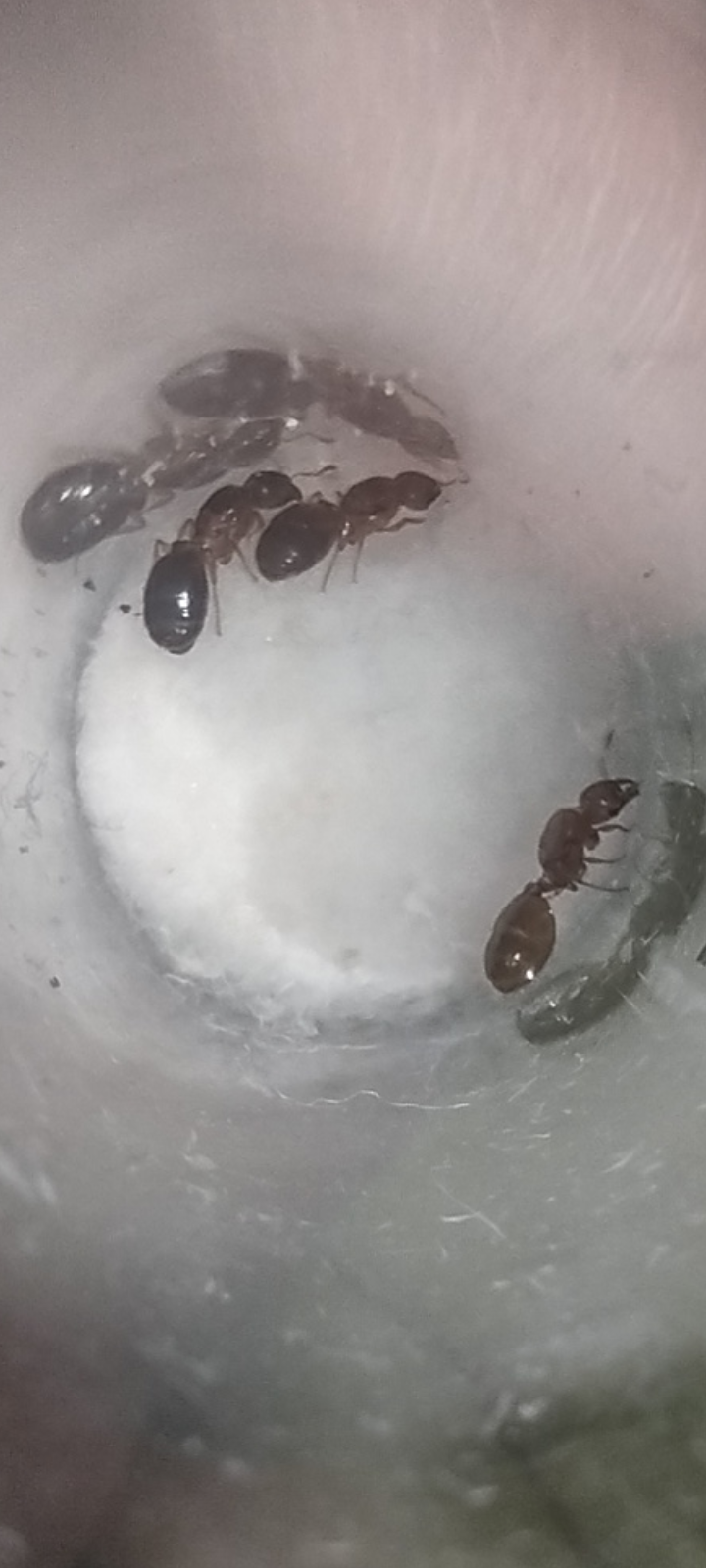
I have the Pheidole queens all the same size but one (which was caught in Southern Virginia instead of Charlottesville) is orange instead of red. I believe Pheidole Denata and Morrisi. I placed then into the the one that had brood's test tube. I forgot to dip them into vinegar but they seem to have settled in.
If you can help with ID that would be great.

#136
 Offline
-
Posted July 31 2023 - 2:47 PM
Offline
-
Posted July 31 2023 - 2:47 PM
Can I use this kind of vinegar to take the scent off of workers from one myrmecocystus colony so I can add them to another? 
Edited by Tanks, July 31 2023 - 2:50 PM.
#137
 Offline
-
Posted August 3 2023 - 1:39 PM
Offline
-
Posted August 3 2023 - 1:39 PM
Sad news, the orange Pheidole queen came out on top and killed the other queens. I thought it would be the other way around.
Edited by Virginian_ants, August 3 2023 - 1:39 PM.
#138
 Offline
-
Posted August 3 2023 - 3:58 PM
Offline
-
Posted August 3 2023 - 3:58 PM
There is a reason this thread went dead years ago.
- Virginian_ants and 100lols like this
"The ants are a people not strong, yet they prepare their meat in the summer." Prov. 30:25
Keep ordinary ants in extraordinary ways.
Keep ordinary ants in extraordinary ways.
#139
 Offline
-
Posted August 3 2023 - 4:01 PM
Offline
-
Posted August 3 2023 - 4:01 PM
Yes, I will buy try again in the future.
1 user(s) are reading this topic
0 members, 1 guests, 0 anonymous users










